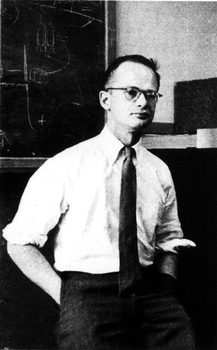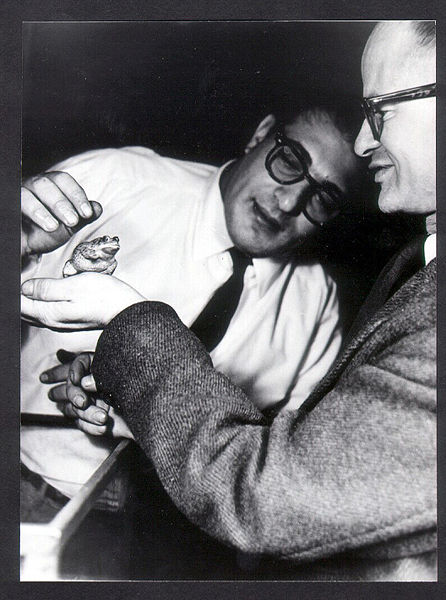 |
 |
| Walter Pitts | Walter Pitts with Jerry Lettvin From Wikipedia: http://en.wikipedia.org/wiki/File:Lettvin_Pitts.jpg |
Walter Pitts
 |
 |
| Walter Pitts | Walter Pitts with Jerry Lettvin From Wikipedia: http://en.wikipedia.org/wiki/File:Lettvin_Pitts.jpg |
Walter Pitts
1923-1969
Walter Pitts was born in Detroit on April 23, 1923. Pitts apparently ran away from home at the age of 15. Instead of joining the circus, he went to the University of Chicago, where he sat in on Bertrand Russell's lectures, and gave Rudolph Carnap a copy of Carnap's "Aufbau" with corrections and suggestions for improvements one office hour. Pitts never received a degree, despite the best efforts of Carnap and others, but he found a home in the house of Warren McCulloch. Pitts wrote a number of articles on neuronal functioning as it relates to computation. Though Pitts is now well-known for his paper treating the nervous system as a digital computer, Pitts wrote extensively about dynamic neural networks and learning by those networks. In 1942, Pitts wrote and published "Some Observations on the Simple Neuron Circuit " in Bulletin of Mathematical Biophysics, volume 4, number 5. Pitt's abstract for this article reads as follows:
| A new point of view in the theory of neuron networks is here adumbrated in its relation to the simple circuit: it is shown how these methods enable us to extend considerably and unify previous results for this case in a much simpler way. (p.121) |
In the very next issue of that journal Pitt wrote and published "The Linear Theory of Neuron Networks: The Static Problem" in Bulletin of Mathematical Biophysics, volume 4. Pitt's abstract for this article reads as follows:
| The construction of a theory of activity in neuron networks of arbitrary topological structure is commenced under the linear excitation hypothesis: we consider conditions for possible steady-state equilibria, deferring a dynamical treatment to the sequel. (p. 169) |
In the next year Pitt's published his article, "The Linear Theory of Neuron Networks: The Dynamic Problem" , which he summarizes as follows:
| The development of a general theory of neuron-networks is here extended to cases of non-steady state activity. Conditions for stability and neutrality of an equilibrium point are set up, and the possible functions representing the variation of excitation over time are enumerated. The inverse network problem is considered—which is, given a preassigned pattern of activity over time, to construct when possible a neuron-network having this pattern. Finally, a canonical form for neuron networks is derived, in the sense of a network of a certain special topological structure which is equivalent in activity characteristics to any given network. (p.23) |
McCulloch and Pitts coauthored and published "A Logical Calculus of the Ideas Immanent in Nervous Activity" and a related note, "A Statistical Consequence of the Logical Calculus of Nervous Nets," illustrating how the brain could be understood as a digital computational device in 1942. The paper and note appeared in the Bulletin of Mathematical Biophysics, volume 4. Interestingly, another paper by Pitts (with Jerry Lettvin) also appeared in that volume. This latter paper offers a mathematical theory of affective psychoses in terms if two variables; intensity of emotion and intensity of activity. Though the first paper is well known for influencing John von Neumann and the development of digital computing and cybernetics, the latter apparently was written as a practical joke. Pitts was first a graduate student in mathematics and then a lecturer at MIT from 1946-1969. From 1952-1969 he was part of the Electronics Research Laboratory at MIT, but he seemed to spend much his time in bars reading. In 1959 and 1960 Pitts published two more highly influential papers, "What the Frog's Eye Tells the Frog's Brain" and "Anatomy and Physiology of Vision in the Frog" with Jerome Lettvin and Humberto Maturana. On May 14, 1969 Pitts died of bleeding from esophageal varices (abnormally swollen or dilated blood vessels).